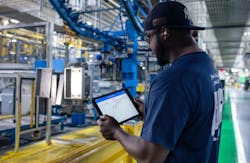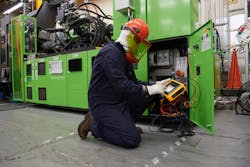In 2020, Schneider Electric’s Lexington, Ky., facility—a 60-year-old brownfield facility where safety switches and circuit breakers are produced— was recognized as a “Lighthouse Factory” by the World Economic Forum (WEF), which, together with McKinsey & Company in 2018, created the Global Lighthouse Network initiative. “Lighthouse Factories” are companies that effectively use Industry 4.0 technologies to drive digital transformation. As a result, these companies are recognized as beacons for others to follow.
The Lexington factory’s digital energy management strategy leverages IIoT (Industrial Internet of Things) connectivity with power meters and predicative analytics to capture greater energy consumption granularity and optimize energy costs. As a result, the company has been able to reduce energy use by 26%, net CO2 by 30%, and water use by 20%. Based on that progress, the Schneider Electric factory was selected by WEF in 2021 as one of only three facilities in the world to be named a “Sustainability Lighthouse.”
“It’s a testament to the work we’ve been doing in Lexington, and a reflection of the broader Schneider mission,” said Luke Durcan, Schneider Electric’s director of the company’s EcoStruxure platform. “We have been on the decarbonization sustainability path for many years.”
Decarbonization is part of the company’s commitment to Sustainable Development Goals (SDGs), a universal call to action by the United Nations which outlines a collection of 17 interlinked global goals designed to be a "blueprint to achieve a better and more sustainable future for all." Schneider Electric is engaged in efforts to accomplish all 17 SDGs, as well as five sustainability megatrends related to climate, the circular economy, ethics, health and equity, and development.
For its core business, Schneider is transitioning to more electric, digital, decarbonized, and decentralized energy. The company notes that it is committed to carbon neutrality at its sites and in its ecosystem by 2030. “As a manufacturer of things, this is aggressive,” Durcan said.
As aggressive as Schneider Electric’s actions around sustainability are, more companies are following a similar path. According to a Capgemini Research Institute report on sustainable operations, of the 960 executives surveyed, 91% aim to achieve 100% renewable electricity and 87% plan to be carbon neutral by 2040.
Achieving this, however, takes intent and technology. “We have a decarbonization pathway which is a four-stage, 12-point plan to understand the baseline and set targets,” Durcan said. And Schneider Electric uses some of its own technology to understand the actual base level in the plant. This technology includes its PowerLogic power meters, the EcoStruxure Power Monitoring Expert energy visualization and analysis tools that collect metering and machine data at the control layer, and Aveva Insight—a cloud platform that uses artificial intelligence to create actionable information to improve asset reliability and operational performance from enterprise systems, MES (manufacturing execution systems), time series, and non-sequential energy data.
Schneider Electric says its manufacturing customers are using the same technologies for their own sustainability initiatives. “To say there’s been an explosion in the last 12 months is an understatement,” Durcan said. “There’s been a seismic shift in people’s decarbonization efforts.”
But this move to energy efficiency and carbon neutrality does not come naturally, and manufacturers need a lot of help when it comes to getting started.
Letting off steam
A common question is: “Where do I start?”
And a common answer is, “Start by doing an
assessment on where the greatest gains can
come from with the least amount of effort,”
said Nathan Hedrick, national product manager
at Endress+Hauser. “Typically, I find
that some of the biggest energy consumers
are compressed air and steam where small
changes can lead to big savings.”
Indeed, industry experts agree that steam, compressed air, and electromechanical systems are the biggest culprits when it comes to wasted energy. Fortunately, relatively easy fixes exist for these issues as long as you can measure energy use in these areas first.
Endress+Hauser makes field instruments to measure and monitor the flow, level, pressure, and temperature of liquids. “These instruments are the eyes and ears into the process and are important to sustainability efforts because they can generate baselines that can be monitored, measured, and reported on to see trends,” said Mark Thomas, Endress+Hauser’s industry marketing group manager.
Sean Silvey, product application specialist with Fluke Corp., a supplier of electrical test and measurement tools, agrees that an energy assessment is a good first step. “But in energy, there isn’t a body of research for an industrial plant manager to use to set baselines for what ‘reasonable’ energy usage looks like in a manufacturing facility. So how do you assess what portion of current energy usage is reasonable and what is wasteful? Or, of that wasteful portion, what provides high enough ROI (return on investment) to address? The ROI under discussion here is the cost per kilowatt hour as charged by the utility.”
Fluke’s power quality and energy analyzers troubleshoot power quality issues and discover the cost of wasted energy. Multiple parameters are measured simultaneously and displayed in formats that quickly describe overall power quality health. And understanding energy waste points is key. “Every system and operation has the potential to be a point of waste that can be mitigated or remedied,” Silvey said. “The goal is to map the energy use of specific equipment and processes to look at where energy is being wasted to quantify the waste and prioritize improvements or replacements based on life of the equipment, as well as which modifications can deliver the best return on investment.”
Silvey’s “energy efficiency checklist” starts with a profile of energy use and then traces the energy consumption to understand energy waste points. He warns that manufacturers should not try to manage every kilowatt consumed by the facility, but instead divide the facility by electrical infrastructure and key systems. “The understanding of basic energy components enables an electrician to set up energy logging equipment to measure overall levels and quality of consumption and then trace when energy is consumed by what. The biggest power savings come from determining when power usage peaks, evaluating overall power consumption compared to utility invoices, and possibly rebalancing loads.”
By power logging each major system and mapping those costs against utility bills to quantify where and when consumption occurs, companies can often realize savings by simple operational and schedule changes, Silvey said.
Measuring for more output There are other ways to measure energy use beyond checking the utility bill, and it starts with collecting the data from an energy meter connected to an equipment component—a conveyor or a pump, for example—and putting it into a historian as a way to maintain the history of the equipment to look for optimizations. “As you monitor it over time, using a dashboard, you then have a data set and can use analytics to get efficiency,” said Gimmi Filice, senior product manager at GE Digital.
In addition to historians, MES software can be tied to facility management software to determine when different lines are idle and can be powered down. A large automotive manufacturer using GE Digital’s Proficy MES software saved 10-15% on energy usage just by looking at what lines were not running during certain hours in the evening, dimming the lights, and shutting off high energy equipment, Filice said.
Other customers are taking digital transformation tools to another level, like using artificial intelligence and digital twin technology to make predictions of how equipment will perform. According to GE Digital, a steel, chemicals, and cement conglomerate in Southwest China turned to Proficy CSense (analytics software that improves asset performance using a process digital twin) to optimize control of its energy-intensive cement cooler process. By analyzing the data, new insights were gained about variation in the cement cooler’s performance. A digital twin model enabled them to predict how process input changes would affect the cement cooler’s performance.
Though looking at a portion of data may help tweak a machine or a line, it does not provide the holistic view needed to truly optimize energy use. “I’ve often found that our own instrumentation has a lot more unlocked potential in the form of unused data that users do not fully leverage to their benefit,” said Endress+Hauser’s Hedrick.
That is where new kinds of manufacturing data-capturing technologies are coming into play. An example being Sight Machine, a platform that converts unstructured plant data into a standardized data foundation.
“A manufacturer should know how many units it’s producing and how much energy it’s using, but they need to dial down to see where it’s being used to get to the level of not just plant or line efficiency, but asset efficiency,” said Matt Smith, senior vice president, digital transformation for Sight Machine.
Sight Machine features tools, called “cookbooks,” that contain recipes for products. Using this information, Sight Machine can determine the most efficient way to make these products using statistical weighing. “Cookbooks look through all of the historical data and, based on conditions—be it humidity, raw materials, etc.—give you your best set of running conditions using as little water as possible, for example,” says Smith.
Schneider Electric’s Durcan agrees that the ability to track resource and energy use, not just at the plant level but at the product level, is important. The Lexington plant, for example, is a high-volume, low-mix facility, and when you are producing products the same way every day, managing the resources is straightforward. But that’s rarely the case. “You need to associate the resources with the actual product flowing through the facility. We have to think not just about what a plant does on a week-to-week or year-to-year basis, but how to optimize them,” he said.
That means broadening the scope beyond what is happening in the plant to include the extended supply chain. It can be difficult to collect all that data, but it is an important aspect of measuring energy use. “In the past we’d go to the ERP system to see what standard and variable costs were and see where it is cheaper to produce product, which was all based on cost. Now, we are genuinely looking at our supply chain based on carbon and resources, and that is a different proposition,” Durcan said. “Cost is not a reflection of carbon and energy produced.”
There are numerous aspects to understanding energy use, and there is no one approach that works for all cases. To address this, many manufacturing technology suppliers, like Schneider Electric, have formed consulting groups to help companies establish baselines and measurements. But to be successful, there needs to be “strategic corporate intent,” Durcan said. “Everyone is at a different point on the journey; make sure you are strategic about what the objectives are first.” Fluke’s three-phase power quality analyzers capture hundreds of power quality parameters to ensure critical power quality events are never missed.




